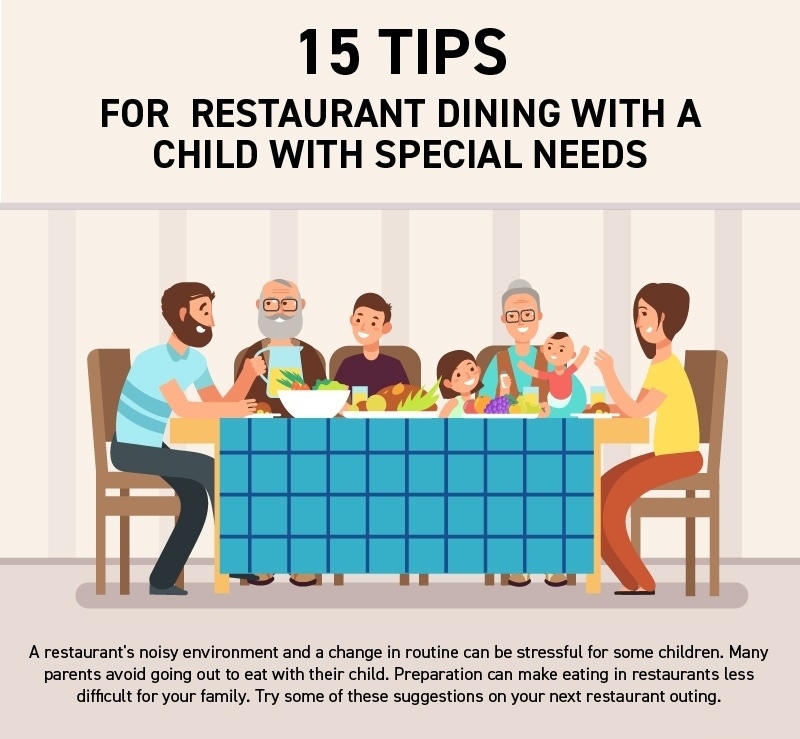Is going out to eat as a family a struggle? A restaurant's environment and the change in routine can be stressful for your child, and thus your whole family. Many parents find it easier to avoid going out to eat with their children and just stay home for meals, but that’s not always practical and not very fun. With some preparation, you can make eating in restaurants less difficult for your family.



15 Tips for a Successful Restaurant Outing for Special Needs Children
Remember, you know your child best and what he or she can and can’t handle. Review these suggestions and follow the ones that you think will work best for your son or daughter. Be patient and slowly work up to eating out.
Before Leaving for the Restaurant
1. Prepare your child for what to expect at a restaurant. You can play pretend restaurant, taking turns being the waiter and customer. Or act out proper manners using stuffed animals or dolls to create a tea party or dinner out.
2. Create a social story sharing how to behave at a restaurant. Social stories share social information in a clear manner to help your child understand. They’re personalized short stories written in first person.
3. Display the steps to eating out in a visual support. Visual supports help children who have difficulty with language understand through pictures or drawings. You could create one showing the different steps of eating at a restaurant.
4. Check out the menu beforehand to make sure your child has something to eat. Many menus are online or you can call and ask the restaurant. At first, you could bring food from home if you think the overall experience could be too overwhelming.
5. Make a reservation or call ahead to reduce your wait time. All children have a limited amount of patience. Don’t spend all of their good behavior time waiting to be seated. Choose somewhere without a wait when dining out for the first time. Let the hostess know that you have a child with special needs; the restaurant may have accommodations that they can provide, such as a quieter table.
6. Bring along quiet toys to help pass the time. They could be tactile, like putty, or visual, like a coloring book or picture book. New toys will keep your child’s attention better than old ones, so consider having some special toys reserved for playing with only at restaurants.
7. Pack snacks like grapes, cheese, or pretzels. If your child gets hungry while waiting for food, offer a small snack to satisfy and distract them while you wait. Noise cancelling headphones and a weighted blanket can also be helpful.
8. Adaptive silverware and scoop dishes from home can make dinner easier. It helps keep one part of the meal the same, limiting the amount of change. If your child uses assistive cutlery bringing it along lets them continue to eat independently.
At the Restaurant
9. Eat early to avoid the crowds and longer wait times. Going to the restaurant at 4:30 p.m. or 5:00 p.m. for dinner cuts down on the noise level and number of people present that could agitate your child. Fewer people also lets the staff give your table more attention and quicker service.
10. Request a corner booth to limit disturbances. You probably also want to avoid sitting near the kitchen or restrooms where people will constantly be passing by.
11. Start small, maybe you only stay for appetizers. It’s okay to work up to eating a whole meal out. Dessert can be a fun way to introduce eating at a restaurant to your child.
12. Help the restaurant staff understand what you need. Tell the waiter you’re in a hurry or explain that your child has special needs and what will be helpful as you dine. Maybe your child needs to hear the question a few times before answering what he wants to drink or perhaps your child is non-verbal and you will order for them or have them point to what they want on the menu.
13. Anticipate the need for refills and ask before your child’s cup is empty. Prevent meltdowns by preparing for what your child will want and limiting their wait.
14. Ask for the check when the food arrives. After dinner, your child might be ready to move onto the next thing. Getting the check beforehand lets you leave when necessary.
15. Last tip, have a plan in case the restaurant becomes too stimulating. Take your child for a walk or to sit in the car if they need a break.
Eating at a restaurant with your family can be enjoyable. There will be an adjustment period, but if you follow these tips and prepare ahead of time, it can become easier for your family to dine out.
Medical Disclaimer: The information provided on this site, including text, graphics, images and other material, are for informational purposes only and are not intended to substitute for professional medical advice, diagnosis or treatment. Always seek the advice of your physician or other healthcare professional with any questions or concerns you may have regarding your condition.








 France
France Australia
Australia



